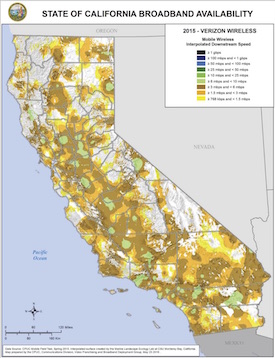
Click for the big, ugly picture.
Don’t believe the broadband speed levels that mobile carriers – AT&T, Sprint, T-Mobile and Verizon – claim to deliver. That’s what the California Public Utilities Commission is telling its counterpart in Washington, the Federal Communications Commission. Unlike the FCC, the CPUC has a rigorous, longstanding mobile data testing program that includes analysis based on what an actual customer would experience.
If you take Verizon at its word, for example, 99.6% of Californian homes would be getting mobile broadband service at the CPUC’s minimum 6 Mbps download and 1.5 Mbps upload speeds. But the CPUC’s actual field tests say that’s bunk, and so are similar claims by other mobile carriers…
By contrast, relying on field testing data from Fall 2015, staff lowered the mean by 2 standard deviations to estimate speeds with 98% reliability. With this adjustment, [CPUC] staff found that only 9% of California households have access to a combined 6 Mbps down and 1.5 Mbps up or faster service. For all four major mobile providers (AT&T, Sprint, T-Mobile, and Verizon), only 16% of California households can expect access to mobile broadband at those levels (about 98% of the time). Moreover, while the FCC has established a mobile standard for “advanced telecommunications capability” of 25 Mbps down and 3 Mbps up, the CPUC’s analysis, taking variability and other indices of quality into account, shows no California households with access to that service.
The gap between advertising claims and the truth, and between urban and rural areas, widens even further when video is factored in…
One-way streaming video service substantially degrades when the user moves from urban to rural areas. This degradation is characterized not only by a decrease in video quality, but also by a dramatic increase in locations with no video capability at all. For AT&T, the number of locations with no video service more than quadruples from 5% in urban areas to 23% in rural areas; for Sprint the numbers change from 10% to 23%; for T-Mobile, 7% to 29%; and for Verizon, 4% to 22%.
More information can be had on CPUC staffer Rob Osborne’s excellent blog (h/t to Jennifer Riggs at CETF for the pointer).
CPUC comments to the FCC regarding mobile wireless, 31 May 2016
Wireless Streaming Video in California – Spring 2015, CPUC report, January 2016
